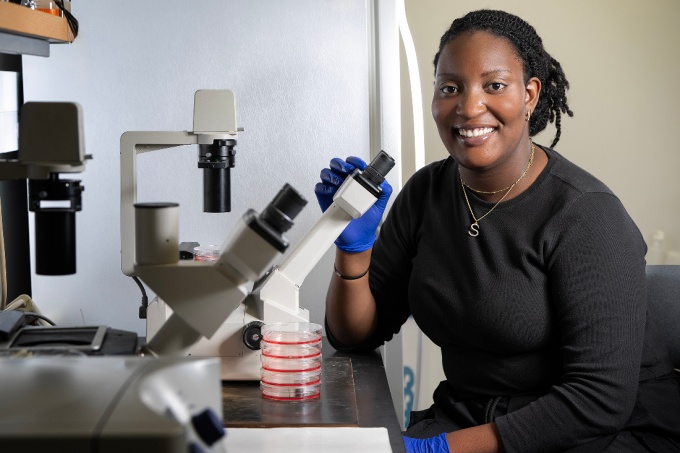Computational Cell Biology, Anatomy & Pathology (MS)

Master’s student Sefunmi Babatunde uses a microscope to check the cell confluence of mouse embryonic fibroblasts.
The future of research in the fields of cell biology, anatomy, and pathology will be dominated by scientists whose knowledge of biological structure is supplemented by proficiency in imaging methodology and quantitative approaches. The master’s program in Computational Cell Biology, Anatomy & Pathology seeks to position graduates to best engage in that environment. We provide training in those traditional biological subjects while incorporating digital image analysis and computational modeling in our core courses.
Trainees are prepared to pursue careers or further training in biomedical research in academia, industry or national laboratories, especially in work that requires knowledge of biological structure and an ability to analyze it. Research by our faculty employs imaging, genetics, and cellular, molecular and biochemical analyses to examine biological function in a range of organ systems. Data from these varied approaches can be aligned with computational tools in order to gain novel insights into very complex phenomena and yield new understanding of disease mechanisms and treatments. We offer state-of-the-art instruction in both the biological principles and the quantitative methodologies. We aim to instill our trainees with a solid foundation in both the macro- and microscopic realms, and enable them with proficiency in biomedical imaging and data analysis.
The Program
Our program emphasizes research over didactic study. Our faculty are engaged in research in cell and developmental biology, systems biology and informatics, bioimaging and neuroscience.
Research projects tend to be highly interdisciplinary, with faculty collaborations in the Canon Stroke & Vascular Research Center, Roswell Park Comprehensive Cancer Center, and the Departments of Computer Science, Electrical Engineering, Materials Design and Innovation, and Mechanical Engineering, as well as other departments within the Jacobs School of Medicine and Biomedical Sciences. To accommodate such diverse interactions, coursework requirements are a kept at a minimum and it is the advisor's responsibility to arrange with the student, at the time of entry, a tentative program of study.
Academic Requirements
Students must complete a one-semester course in Machine Learning for Biomedical Data and at least one semester of one of the following: Form Function and Visualization of Human Gross Anatomy; Microscopic Anatomy with an Introduction to Computation Methods; or Quantitative Neuroanatomy. Students also participate in a one-credit departmental seminar course devoted to developing scientific communication skills during every semester they are in the program.
The remainder of the program is developed on an individual basis but, in general, comprises interdisciplinary courses, courses in areas relevant to the student's research, and a substantial thesis or project prepared under the supervision of a full time department faculty member and committee selected by the student and faculty advisor.
Research or Special Project
The main requirement for the Master's degree in our program is completion of (a) a research thesis describing hypothesis-driven experimental work, or (b) a special project constituting novel work advancing a technical or instructional aspect of Anatomical Sciences. The subject of the thesis or project must fall within the interests and expertise of program faculty, and the scope of the work generally represents the product of 2-3 semesters of effort. Thus, completion of the program can be expected to take two years.
Course Work
A typical curriculum follows this pattern:
Year 1
Fall semester
- Departmental seminar (1 credit)
- Cell Biology (3 credits) and/or Microscopic Anatomy with an Introduction to Computation Methods (4 credits)
- Research (4-8 credits) – explore research topic(s) and identify thesis advisor
Spring semester
- Departmental seminar (1 credit)
- Form Function and Visualization of Human Gross Anatomy or Quantitative Neuroanatomy (3 or 4 credits)
- General Pathology Introduction (1 credit)
- Research (4-8 credits) – begin focused work on thesis/project
Summer
- Research
Year 2
Fall semester
- Departmental seminar (1 credit)
- Cell Biology, Microscopic Anatomy with an Introduction to Computation Methods, if needed; other elective or advisor-mandated course(s) (3-7 credits) Common elective classes include Optical Microscopy and Imaging; Introduction to Biomedical Image Analysis; Neuroscience.
- Research (5-9 credits) – continue thesis/project research
- Submit "Application to Candidacy"
Spring semester
- Departmental seminar (1 credit)
- General Pathology Introduction, Quantitative Neuroanatomy or other elective course (optional)
- Research credits as needed to reach 30; complete thesis/project research
- Master’s defense
Contact Us
Director of Graduate Studies

Department of Pathology & Anatomical Sciences Jacobs School Room 4258 955 Main St Buffalo, NY 14203
Phone: 716-829-3527; Fax: 716-829-2725
Email: kolega@buffalo.edu